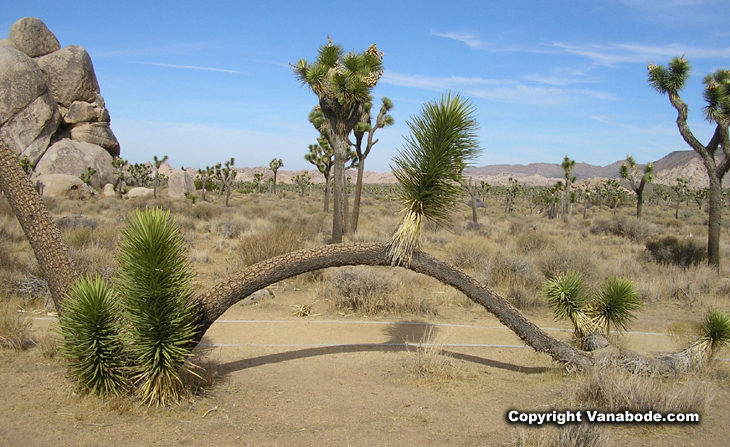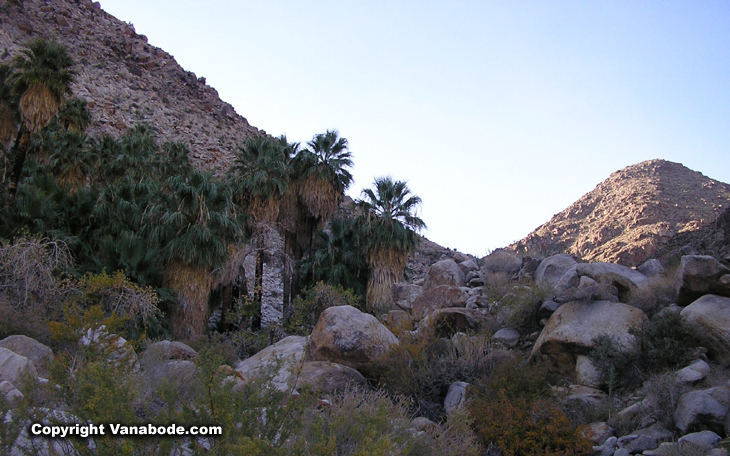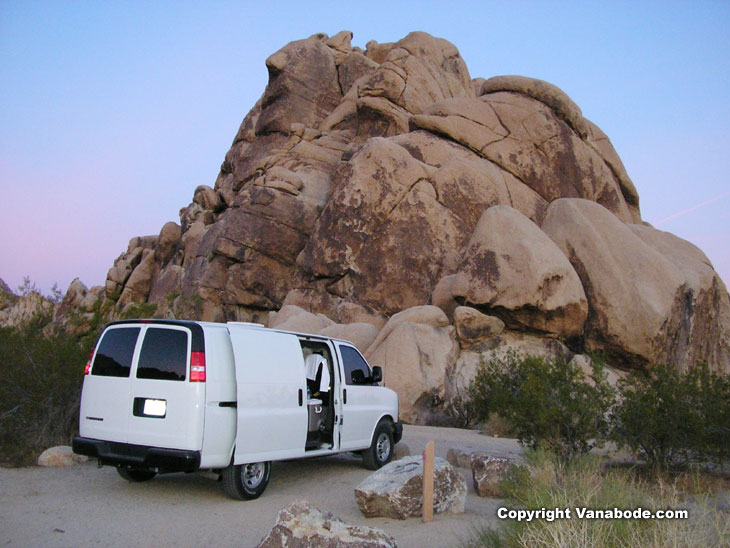
Overview Who Needs This? Excerpts Order Book Pictures Chapters
Answers Reviews Destinations Free Stuff More Contact Us
Joshua Tree National Park Pictures
I can't think of any other national park where the campsites are private and breath taking all at once. Joshua Tree National Park lies within two deserts, two large ecosystems, and even more strange are the five palm oases within it's boundaries.

| Hiking to the real oasis shown in the pictures was great fun. Easy at a medium pace with some good elevation change providing a great view of surrounding valleys and the oasis buried deep in a hidden canyon. We were there for 2 hours and nobody showed up so we had the place to ourselves. Most of the hikes in Joshua Tree park are low commitment meaning you can hike a little but see a lot. Go during the week to avoid the crowds and go when it is about 60-80 during the day which makes for perfect hiking and great sleeping at night at around 25 degrees cooler. |
The two deserts are primarily determined by elevation between the high and the low deserts. In the western half of the park is the Mojave Desert which is higher, moister, and cooler, elevations from 3,000 to 5,000. This is where you will find the special habitat of the Joshua trees. The Colorado Desert sits below 3,000 feet and occupies the eastern half of the park. It is dominated by the creosote bush with cholla cactus and patches of ocotillos. There are also five fan palm oases where water occurs naturally at or near the surface and abound with wildlife.
|
|

Joshua Tree's grow about an inch per year. I'm 64" tall so this tree is about 384 years old.
We traveled from Las Vegas going west on I-15 and then exited on Cima Road in California. I love to take back roads every chance I get. Unbeknownst to me (the trip planner) this is the boundary for the Mojave National Preserve. Ohhh myyy, a totally gigantic Joshua Tree forest. The Joshua Trees at the national park dot the terrain, but the trees in the preserve were beyond abundant and seemed much, much larger than the NP's trees. We passed the Kelso Sand Dunes, Mitchell Caverns, and the Granite Mountains. As we were passing all of these incredible sites and opportunities I was questioning our continued efforts to Joshua Tree National Park. However, we persevered and was pleased to visit one more national park with all of its preserved glory. The roads we took to Joshua Tree were what I would call paved dirt roads, this includes I-15. Twisty, curvy, uneven, bumpy, with car sick hills and dips - a little easier if you're the driver - but the sites we witnessed were unforgettable.


Above: Jason cooking our dinner over a cast iron pit at the White Tank Campground. You can see by the shadows that the sun was setting and before too long the cool temperatures crept in quickly.

Our first night we stayed at White Tank campground. It is the smallest campground in the park with only 15 sites and they are nestled among attractive large boulders. The Arch Rock nature trail starts from this campground. Look for White Tank which you will find from the wash walking back towards the campground. This is a tall cement dam put here for cattle in the 1900s.


Early in the next morning we drove south on Pinto Basin Road. The scenery and terrain change as the road descends to the Colorado Desert. You see a cactus, then another, and the next thing you know you are surrounded by the cholla cactus. Walking the nature trail at sunrise in the Cholla Cactus Garden was remarkable. It was quiet and cool and there were birds and jack rabbits all around. The Ocotillo Patch is not much further and if you are into desert plant species then you will understand how precious it is to see ocotillos in the wild.

We headed back north and walked the nature trails of Skull Rock, Hidden Valley, Keys View, and Barker Dam. Since we visited the park in November darkness settled in around 5:00 p.m. Therefore, we were trying to get to Indian Cove in time to find a camping spot, cook our dinner, and read before practically being forced to go to bed early. Of course we lounged in our chairs wrapped in sleeping bags stargazing but we were tired so bedtime was around 6:00 p.m. Which, by the way, makes for a really, really long night. Fall temperatures are great but perfection would be darkness at 9:00 p.m.

Above: Picture of the beautiful scenery of the Hidden Valley hiking path.
From the Indian Cove campground we planned a hike to Fortynine Palms oasis on the morning of our last day. It is rated as moderately strenuous but we didn't find it too strenuous. However, Jason's inner thighs were sore for about four days, so that would make it post-hike moderately strenuous. For me, I was glad to get a glute and quad workout. Jason could have spent half the day at the oasis. It was cool and moist and teaming with birds. We really wanted to see some Big Horn Sheep at the watering hole but we didn't. We scrambled around a bit and sat quietly to listen to the birds, the water trickling and palm fronds creaking. It is a beautiful hike and coming back to the parking lot you get great views of Twentynine Palms.

There are a few backcountry roads but we opted not to drive any this trip. It probably has something to do with the Race Track in Death Valley and $690 we just spent on new wheel bearings on our 2006 vehicle. However, my next trip to Joshua Tree will include some research on the conditions of the backroads this way Jason won't hate me while he is changing a flat tire or trying to dig us out of soft sand.

Above: Jason at the edge of a natural spring in 49 Palms.
If you have never been to Joshua Tree National Park either because you don't like the desert environment or because you don't climb rocks then you are really missing out. It is not only about those two things and the five fan palm oases in the park will prove it. When people think desert they think hot. In the summer it's hot everywhere even in Fairbanks, Alaska. Go in the Spring or Fall and you will enjoy your trip.
Jason's thoughts - Hiking to the real oasis shown in the pictures was great fun. Easy at a medium pace with some good elevation change providing a great view of surrounding valleys and the oasis buried deep in a hidden canyon. We were there for 2 hours and nobody showed up so we had the place to ourselves. Most of the hikes in Joshua Tree park are low commitment meaning you can hike a little but see a lot. Go during the week to avoid the crowds and go when it is about 60-80 during the day which makes for perfect hiking and great sleeping at night at around 25 degrees cooler. Thanks K!
Kelly's thoughts - I love that the scenery was always changing either driving on Pinto Basin Road or Park Boulevard. My favorite was the Cholla Cactus Garden. I also really enjoyed being able to see so far due to the desert terrain which is open and not cluttered with tall brush. Our camping spots were awesome too.



Travel Info - RV's will have no problem in this park. There are two campgrounds that have dumping stations. Not all campgrounds can accommodate RVs or trailers due to length restrictions, so check at any of the three visitor centers first. Camping spots are only $10 - $15 per night but bring correct change because there is often not a ranger to talk to at the spot. Travel 140 miles east of Los Angeles to visit Joshua Tree National Park California.
Click for unforgettable pictures and experiences on this affordable 10,524 mile 17 week trip.


Home
Contact Us Copyright
© 2007-2016 Free
Guide They Hate Me
Privacy
Policy Terms
and Conditions Media
Press Affiliate
